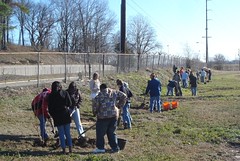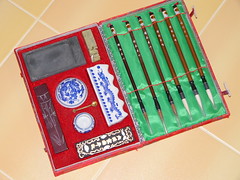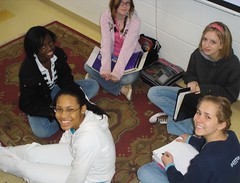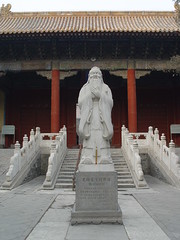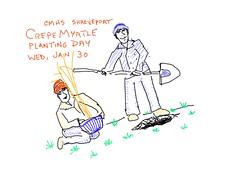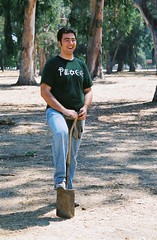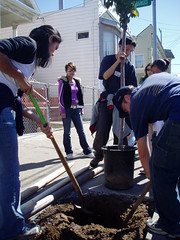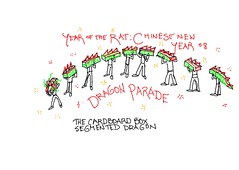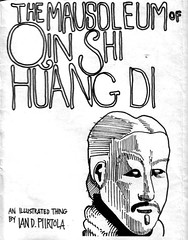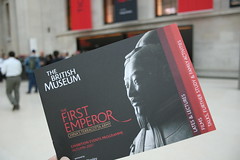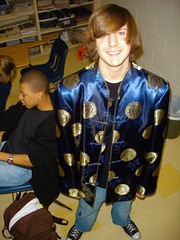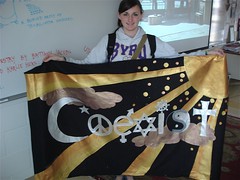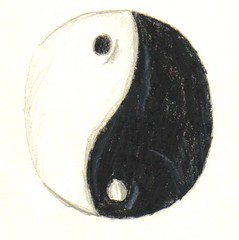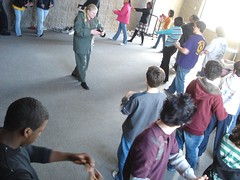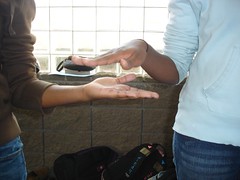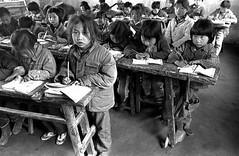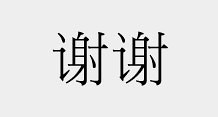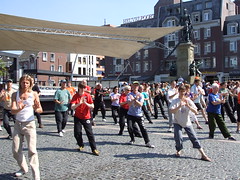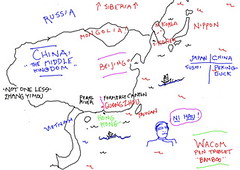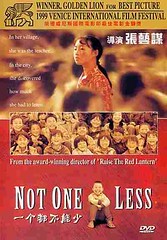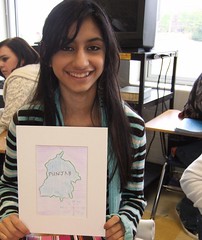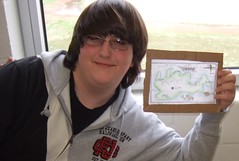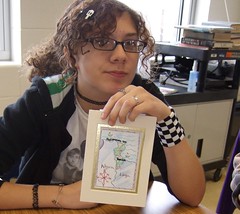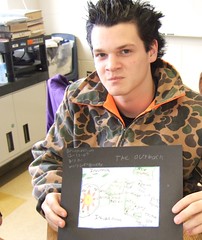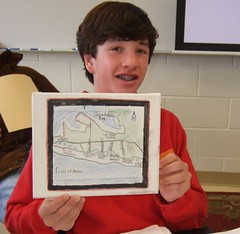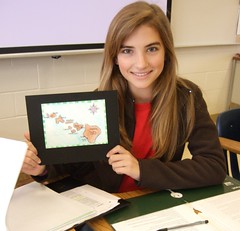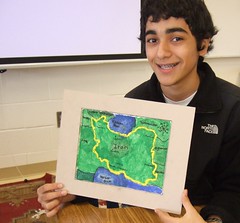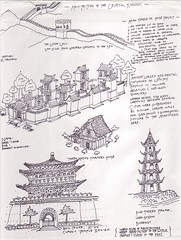The rubric (required elements) that will guide essay writing in geo class includes:
1. Colorful opening. There are 3 recommended ways to create an interest-getting opening: a) use a quote b) ask a question c) write with vivid description.
2. Blend the topics continually in the paper. Do not write a block of material about one topic and then write a separate block about the other topic. Integrate the topics as you offer insight and evidence.
3) Use comparison terms:
* different from,
* the same,
* Both,
* similar to,
* Neither, ... nor,
* like X is (adjective),
* ... than X is (adverb) than.
* both, ...
* either...or
* likewise
* similarly
* although,
* but neither...
* nor
* however
* on the other hand
4. Specific examples must be used to support generalities. An example: generality - The Incredibles was an awesome movie. specific - The Incredibles appealed to me because the characters (especially the mom and the teen sister) were believeable. They sounded like people I know.
5. Grammar counts.
6. Spelling, too. When in doubt, see a dictionary or ask me.
7. Punctuation is paramount. Again, ask me or your Grammar Check software.
8. Include documentation via "according to ...". This means include your source - from World Book to your little brother - in the body of your writing. Usually you place it at the end of the first or second sentence, says Grammar For Today.
9. Write a snappy title. Ways to make a title fun are to tweak a song or movie title or use alliteration. Also, write an explanatory subtitle. Example: "Dinkas are Incredibles;" "Many refugees from the Sudanese Dinka tribe have moved from poverty in east Africa to comfort in the US."
10. Finally, please don't put quotation marks around your title - unless you are quoting someone.
Thursday, January 31, 2008
Slight re-statement: Boat on a roof essay guidelines
Boat on a Roof guidelines: students worked on 2 guidelines in essay writing for geography class this week. I call them Boat on a Roof guidelines because such a photo was one of the most dramatic images we viewed at Meadows Museum.
The reason for emphasis on these guidelines is because they will make a you a more forceful writer. The world is very competitive and use of these techniques may give you an edge.
A 2-part title is the mark of a good writer.
a) Snammy title. Brief.
b) Explanatory subtitle. What we call the hard info.
A vivid opening is a classic standard for effective writing.
a) Open with the strongest image, such as a Boat on a Roof.
b) A quote is also effective: "A boat on a roof was among the images viewed by students . . . " Also, a question is not a bad fallback in writing an opening.
Which do you like best?
- Dog bites man in CMHS incident
- Man bites dog in incident at CMHS
The reason for emphasis on these guidelines is because they will make a you a more forceful writer. The world is very competitive and use of these techniques may give you an edge.
A 2-part title is the mark of a good writer.
a) Snammy title. Brief.
b) Explanatory subtitle. What we call the hard info.
A vivid opening is a classic standard for effective writing.
a) Open with the strongest image, such as a Boat on a Roof.
b) A quote is also effective: "A boat on a roof was among the images viewed by students . . . " Also, a question is not a bad fallback in writing an opening.
Which do you like best?
- Dog bites man in CMHS incident
- Man bites dog in incident at CMHS
Tuesday, January 29, 2008
Mitt Romney: presidential candidate bio series
Willard Mitt Romney (born March 12, 1947 in Detroit, Michigan) is an American businessman and politician, says Wikipedia.org. Formerly the Governor of the Commonwealth of Massachusetts, Romney is seeking the Republican nomination in the 2008 United States presidential election.[1]
Romney is a former CEO of Bain & Company, a management consulting firm, and the co-founder of Bain Capital, a private equity investment firm. After his business career and serving as the CEO of the 2002 Winter Olympics, Romney was elected as the 70th Massachusetts Governor in 2002. Romney served one term and did not seek re-election in 2006; his term expired.
Romney is the son of former Michigan Governor and 1968 presidential candidate George W. Romney, and 1970 Michigan U.S. Senatorial candidate Lenore Romney. He was named "Willard" after hotel magnate J. Willard Marriott, his father's best friend.[3] Mitt, his middle name, comes from his father's cousin Milton Romney, who played quarterback for the Chicago Bears from 1925 to 1929.[4] Mitt Romney has three older siblings: Lynn Romney Keenan; Jane Romney Robinson; and G. Scott Romney.[5] He has been involved in politics from an early age, having joined his father in civil rights marches.[6]
Romney graduated from the Cranbrook School in Bloomfield Hills, Michigan in 1965.[7] After attending Stanford University for two quarters, Romney served in France for 30 months as a missionary for the LDS Church.[8]
After his mission service, Romney attended Brigham Young University, where he graduated as valedictorian, earning his Bachelor of Arts degree summa cum laude in 1971.
In 1975, Romney graduated from a joint Juris Doctor / Master of Business Administration program coordinated between Harvard Law School and Harvard Business School. He graduated cum laude from the law school and was named a Baker Scholar for graduating in the top five percent of his business school class.[9]
After graduation, Romney remained in Massachusetts and went to work for the Boston Consulting Group, where he had interned during the summer of 1974.[10] From 1978 to 1984, Romney was a vice president of Bain & Company, Inc., another management consulting firm based in Boston. In 1984, Romney left Bain & Company to co-found a spin-off private equity investment firm, Bain Capital.[11]
During the 14 years he headed the company, Bain Capital's average annual internal rate of return on realized investments was 113 percent,[12] making money primarily through leveraged buyouts.[13] He invested in or bought many well-known companies such as Staples, Brookstone, Domino's, Sealy Corporation and Sports Authority.[14]
In 1990, Romney was asked to return to Bain & Company, which was facing financial collapse. As CEO, Romney managed an effort to restructure the firm's employee stock-ownership plan, real-estate deals and bank loans, while increasing fiscal transparency. Within a year, he had led Bain & Company through a highly successful turnaround and returned the firm to profitability without layoffs or partner defections.[12]
Romney left Bain Capital in 1998 to head the 2002 Salt Lake City Olympic Games Organizing Committee.[15] He and his wife have a net worth of between 190 and 250 million USD.[16]
Mitt Romney is a member of The Church of Jesus Christ of Latter-day Saints (LDS), which makes him a Mormon. His great-great-grandfather, Parley P. Pratt, was among the first leaders in the Latter Day Saint movement in the early 19th century. Mitt's wife Ann converted to the LDS church before they were married in 1969.[76] In addition to his missionary work in France, Romney has served as a part-time lay minister, called a bishop, and has also been a stake president in his church.[77] As part of his religious upbringing, Romney abstains from alcohol and smoking.[78][79][80]
Religion has played a major role in the 2008 presidential campaign, with polls indicating that a quarter of Republican voters are "less likely" to vote for a presidential candidate who is a Latter-day Saint.
Soon after his return from missionary work in France, Romney married high school girlfriend Ann Davies on March 21, 1969.[121] They have five sons--Tagg, (b. 1970), Matt (b. 1971), Josh (b. 1975), Ben (b. 1978) and Craig (b. 1981)--[122] and eleven grandchildren.[123]
Romney is a former CEO of Bain & Company, a management consulting firm, and the co-founder of Bain Capital, a private equity investment firm. After his business career and serving as the CEO of the 2002 Winter Olympics, Romney was elected as the 70th Massachusetts Governor in 2002. Romney served one term and did not seek re-election in 2006; his term expired.
Romney is the son of former Michigan Governor and 1968 presidential candidate George W. Romney, and 1970 Michigan U.S. Senatorial candidate Lenore Romney. He was named "Willard" after hotel magnate J. Willard Marriott, his father's best friend.[3] Mitt, his middle name, comes from his father's cousin Milton Romney, who played quarterback for the Chicago Bears from 1925 to 1929.[4] Mitt Romney has three older siblings: Lynn Romney Keenan; Jane Romney Robinson; and G. Scott Romney.[5] He has been involved in politics from an early age, having joined his father in civil rights marches.[6]
Romney graduated from the Cranbrook School in Bloomfield Hills, Michigan in 1965.[7] After attending Stanford University for two quarters, Romney served in France for 30 months as a missionary for the LDS Church.[8]
After his mission service, Romney attended Brigham Young University, where he graduated as valedictorian, earning his Bachelor of Arts degree summa cum laude in 1971.
In 1975, Romney graduated from a joint Juris Doctor / Master of Business Administration program coordinated between Harvard Law School and Harvard Business School. He graduated cum laude from the law school and was named a Baker Scholar for graduating in the top five percent of his business school class.[9]
After graduation, Romney remained in Massachusetts and went to work for the Boston Consulting Group, where he had interned during the summer of 1974.[10] From 1978 to 1984, Romney was a vice president of Bain & Company, Inc., another management consulting firm based in Boston. In 1984, Romney left Bain & Company to co-found a spin-off private equity investment firm, Bain Capital.[11]
During the 14 years he headed the company, Bain Capital's average annual internal rate of return on realized investments was 113 percent,[12] making money primarily through leveraged buyouts.[13] He invested in or bought many well-known companies such as Staples, Brookstone, Domino's, Sealy Corporation and Sports Authority.[14]
In 1990, Romney was asked to return to Bain & Company, which was facing financial collapse. As CEO, Romney managed an effort to restructure the firm's employee stock-ownership plan, real-estate deals and bank loans, while increasing fiscal transparency. Within a year, he had led Bain & Company through a highly successful turnaround and returned the firm to profitability without layoffs or partner defections.[12]
Romney left Bain Capital in 1998 to head the 2002 Salt Lake City Olympic Games Organizing Committee.[15] He and his wife have a net worth of between 190 and 250 million USD.[16]
Mitt Romney is a member of The Church of Jesus Christ of Latter-day Saints (LDS), which makes him a Mormon. His great-great-grandfather, Parley P. Pratt, was among the first leaders in the Latter Day Saint movement in the early 19th century. Mitt's wife Ann converted to the LDS church before they were married in 1969.[76] In addition to his missionary work in France, Romney has served as a part-time lay minister, called a bishop, and has also been a stake president in his church.[77] As part of his religious upbringing, Romney abstains from alcohol and smoking.[78][79][80]
Religion has played a major role in the 2008 presidential campaign, with polls indicating that a quarter of Republican voters are "less likely" to vote for a presidential candidate who is a Latter-day Saint.
Soon after his return from missionary work in France, Romney married high school girlfriend Ann Davies on March 21, 1969.[121] They have five sons--Tagg, (b. 1970), Matt (b. 1971), Josh (b. 1975), Ben (b. 1978) and Craig (b. 1981)--[122] and eleven grandchildren.[123]
Barack Hussein Obama, a basic bio from Wikipedia.org; first in a series on the presidential candidates
Barack Hussein Obama, born August 4, 1961, is the junior United States Senator from Illinois and a leading candidate for the Democratic nomination in the 2008 presidential election, says Wikipedia.[2][3] The U.S. Senate Historical Office lists him as the fifth African American Senator in U.S. history, the third to have been popularly elected, and the only African American currently serving in the Senate.[4]
Obama was born in Honolulu to a Kenyan father and an American mother. He lived most of his early life in the Pacific island U.S. state of Hawaii. From ages six to ten, he lived in Jakarta, Indonesia. A graduate of Columbia University and Harvard Law School, Obama worked as a community organizer, university lecturer, and civil rights lawyer before running for public office. He served in the Illinois Senate from 1997 to 2004. Following an unsuccessful bid for a seat in the U.S. House of Representatives in 2000, he launched his campaign for U.S. Senate in 2003.
He was elected to the U.S. Senate in November 2004 with a landslide 70% of the vote in an election year marked by Republican gains.
Obama has emphasized ending the Iraq War, increasing energy independence, and providing universal health care as major priorities.[7] He married in 1992 and has two daughters. He has written two bestselling books: a memoir of his youth titled Dreams from My Father, and The Audacity of Hope, a personal commentary on U.S. politics.
Obama was born in Honolulu to a Kenyan father and an American mother. He lived most of his early life in the Pacific island U.S. state of Hawaii. From ages six to ten, he lived in Jakarta, Indonesia. A graduate of Columbia University and Harvard Law School, Obama worked as a community organizer, university lecturer, and civil rights lawyer before running for public office. He served in the Illinois Senate from 1997 to 2004. Following an unsuccessful bid for a seat in the U.S. House of Representatives in 2000, he launched his campaign for U.S. Senate in 2003.
He was elected to the U.S. Senate in November 2004 with a landslide 70% of the vote in an election year marked by Republican gains.
Obama has emphasized ending the Iraq War, increasing energy independence, and providing universal health care as major priorities.[7] He married in 1992 and has two daughters. He has written two bestselling books: a memoir of his youth titled Dreams from My Father, and The Audacity of Hope, a personal commentary on U.S. politics.
Nepotism, cronyism and plutocrats
Under the reading on meritocracy, we saw these terms:
Nepotism, the hiring of relatives to work in your organziation. Americans consider nepotism ok in business but not in gevernment.
Cronyism means hiring your friends. Again, it's considered OK away from government.
Plutocrat? Mitt Romney, worth about $200M, says Wikipedia.
Nepotism, the hiring of relatives to work in your organziation. Americans consider nepotism ok in business but not in gevernment.
Cronyism means hiring your friends. Again, it's considered OK away from government.
Plutocrat? Mitt Romney, worth about $200M, says Wikipedia.
Monday, January 28, 2008
Chinese Caligraphy set: carbon ink stick, ink stone, water jar, brushes
India ink might be called China ink, says wikipedia.
Indian ink (or India ink in American English), also called Chinese ink, is a simple black ink once widely used for writing and printing, and now more commonly used for drawing, especially when inking comics and comic strips, as well as in diamond cutting. Indian ink usually is not suitable for fountain pens, as it will readily clog the pen.
Early treatises on the arts refer to black carbon ink that was prepared by the ancient Chinese and Egyptians. Originally designed for blacking the surfaces of raised stone-carved hieroglyphs, the basis of the ink was a black carbon pigment in an aqueous adhesive or binding medium; for example, a mixture of soot from pine smoke and lamp oil mixed with the gelatin of donkey skin and musk.[1] The ink invented according to legend by the Chinese philosopher, Tien-Lcheu (2697 BCE), became common by the year 1200 BCE.
Indian ink (or India ink in American English), also called Chinese ink, is a simple black ink once widely used for writing and printing, and now more commonly used for drawing, especially when inking comics and comic strips, as well as in diamond cutting. Indian ink usually is not suitable for fountain pens, as it will readily clog the pen.
Early treatises on the arts refer to black carbon ink that was prepared by the ancient Chinese and Egyptians. Originally designed for blacking the surfaces of raised stone-carved hieroglyphs, the basis of the ink was a black carbon pigment in an aqueous adhesive or binding medium; for example, a mixture of soot from pine smoke and lamp oil mixed with the gelatin of donkey skin and musk.[1] The ink invented according to legend by the Chinese philosopher, Tien-Lcheu (2697 BCE), became common by the year 1200 BCE.
Eurocentric society: America
Our heritage is Eurocentric, so we study Asia and other parts of the world with all due diligence.
Is Ammerica truly a meritocracy?
Acc to wikipedia, a Meritocracy is a system of a government or another organization wherein appointments are made and responsibilities are given based on demonstrated ability (merit) and talent rather than by wealth (plutocracy), family connections (nepotism), class privilege, cronyism, popularity (as in democracy) or other historical determinants of social position and political power.
Is Ammerica truly a meritocracy?
Acc to wikipedia, a Meritocracy is a system of a government or another organization wherein appointments are made and responsibilities are given based on demonstrated ability (merit) and talent rather than by wealth (plutocracy), family connections (nepotism), class privilege, cronyism, popularity (as in democracy) or other historical determinants of social position and political power.
Wheelbarrows and gunpowder: a selected list of Chinese firsts in technology
The four great inventyions of China include
- magnetic compass
- paper
- gunpowder
- printing
Additional firsts . . .
# Belt drive
# Blast furnace
# Cast iron
# Chain drive
# Chinese calendar
# Chinese cuisine: Tofu, Ramen sushi
# Chopsticks
# Crossbow (repeating)
# Exploding cannonball
# Fire Arrow
# Gunpowder
# Firearm
# Horse collar
# Hull compartments/bulkheads
# Indian ink
# Kite
# Land mines
# Lottery
# Noodle
# Paper
# Pendulum (Zhang Heng)
# Printing (woodblock printing and movable type)
# Rockets: Fire Arrow, Multistage rocket
# Rudder
# Seismometer (of Zhang Heng)
# Silk
# Stirrup
# Toilet paper
# Wheelbarrow
- magnetic compass
- paper
- gunpowder
- printing
Additional firsts . . .
# Belt drive
# Blast furnace
# Cast iron
# Chain drive
# Chinese calendar
# Chinese cuisine: Tofu, Ramen sushi
# Chopsticks
# Crossbow (repeating)
# Exploding cannonball
# Fire Arrow
# Gunpowder
# Firearm
# Horse collar
# Hull compartments/bulkheads
# Indian ink
# Kite
# Land mines
# Lottery
# Noodle
# Paper
# Pendulum (Zhang Heng)
# Printing (woodblock printing and movable type)
# Rockets: Fire Arrow, Multistage rocket
# Rudder
# Seismometer (of Zhang Heng)
# Silk
# Stirrup
# Toilet paper
# Wheelbarrow
Sunday, January 27, 2008
Confucius practice quiz
C o n f u c i u s q u i z / T r u d e a u
1. In Chinese language the name Confucius would be rendered as a) Lao Tzu b) Master Kung c) Tai Chi
d) the Buddha.
2. Confucius should be classified as a a) social thinker
b) religious leader.
3. He lived about the the year a) 500 BCE b) 300 BCE
c) 300 AD d) 500 AD.
4. There was little or no difference between the philosophy of Confucius and Shi Huang Di. T / F
5. There was little or no difference between the philosophy of Confucius and the ancient guidelines of Taoism. T / F
6. Confucius occupation was a) governmental minister b) prince c) king d) wise pauper.
7. Confucius basically was in favor of a) democracy
b) monarchy c) oligarchy (rule by a small group of men) d) rule by tyrant.
8. He thought that aristocratic parentage was the key to a wise ruler. T / F
9. His ideal ruler was one who “would spread his own virtues to the people instead of imposing proper behavior with laws and rules.” T / F
10. “Never impose on others what you would not choose yourself.” a) Buddha b) Confucius c) Shi Huang Di.
11. Confucianism has been deeply influential in Chinese but not in Vietnamese, Korean or Japanese cultures.
T / F
12. Confucianism is about a) ethics b) ethnics c) ethnocentrism d) ethylism.
Answers: Wikipedia.org on Confucius.
1. In Chinese language the name Confucius would be rendered as a) Lao Tzu b) Master Kung c) Tai Chi
d) the Buddha.
2. Confucius should be classified as a a) social thinker
b) religious leader.
3. He lived about the the year a) 500 BCE b) 300 BCE
c) 300 AD d) 500 AD.
4. There was little or no difference between the philosophy of Confucius and Shi Huang Di. T / F
5. There was little or no difference between the philosophy of Confucius and the ancient guidelines of Taoism. T / F
6. Confucius occupation was a) governmental minister b) prince c) king d) wise pauper.
7. Confucius basically was in favor of a) democracy
b) monarchy c) oligarchy (rule by a small group of men) d) rule by tyrant.
8. He thought that aristocratic parentage was the key to a wise ruler. T / F
9. His ideal ruler was one who “would spread his own virtues to the people instead of imposing proper behavior with laws and rules.” T / F
10. “Never impose on others what you would not choose yourself.” a) Buddha b) Confucius c) Shi Huang Di.
11. Confucianism has been deeply influential in Chinese but not in Vietnamese, Korean or Japanese cultures.
T / F
12. Confucianism is about a) ethics b) ethnics c) ethnocentrism d) ethylism.
Answers: Wikipedia.org on Confucius.
Friday, January 25, 2008
Crepe Myrtle Planting Day by freshmen at CMHS Shreveport, Wed, Jan 30
Need lots of loaner shovels!
10 pts per student per shovel loaned.
Parents welcome.
10 pts per student per shovel loaned.
Parents welcome.
Thursday, January 24, 2008
Parents welcome at any point as Trudeau's classes plant crepe myrtles Wed, Jan 31
See more on the planting plan below.
Parents are welcome at any point although I do not have students between noon and 1:20 due to my planning, duty and lunch time.
Need lots of shovels! Two day loan. If we get enough shovels we can do the job in one day.
More below!
Parents are welcome at any point although I do not have students between noon and 1:20 due to my planning, duty and lunch time.
Need lots of shovels! Two day loan. If we get enough shovels we can do the job in one day.
More below!
Students planting crepe myrtles along the Viking Drive and Stoner Ave fence lines Wed, Jan 31, all classes
Teachers Ken Lerchie and Robert Trudeau conceived the idea of students planting crepe myrtles on the CMHS campus. "First-year students will make an investment in the campus that will pay visual dividends everytime they pass the area," said Lerchie.
"It's public service, it's a lesson in green organization, it's almost public art," noted Trudeau.
Wed, Jan 31, some 62 small crepe myrtle trees will be delivered to campus. Student teams in each of Trudeau's classes will dig the holes, throw in some fertilizer and pop in the crepe myrtles. Then they will top off the hole with the dirt and clean up their shoes and jeans.
The class needs the loan of a bunch of shovels for one, maybe two, days. The more shovels, the quicker we can plant.
"It's public service, it's a lesson in green organization, it's almost public art," noted Trudeau.
Wed, Jan 31, some 62 small crepe myrtle trees will be delivered to campus. Student teams in each of Trudeau's classes will dig the holes, throw in some fertilizer and pop in the crepe myrtles. Then they will top off the hole with the dirt and clean up their shoes and jeans.
The class needs the loan of a bunch of shovels for one, maybe two, days. The more shovels, the quicker we can plant.
Wednesday, January 23, 2008
A precursor of the quiz on Qin Shi Huang Di
Qin Shi Huang Di quiz 1
1. The life of Shi Huang Di: a) 1200 BCE b) 200 BCE c) 200 AD d) fictitious.
2. Shi Huang Di’s version of the Great Wall was called a “precursor” to the later Great Wall. Precursor means
a) small version b) earlier example c) moveable pointer
d) not the approved or “holy” version.
3. Tomb: a) monument b) mound c) subterranean
d) mausoleum.
4. As an audacious autocrat the First Emperor burned and banned writing by __. a) Lao Tzu b) Tao
c) Confucius d) Buddha.
5. The importance of his reign is intact after 2 millennia. That would be some a) 200 b) 2 thousand c) 2 million years.
6. Huangdi was a title created for the First Emperor based upon a) mythical greats b) ancient rulers c) his family
d) warriors.
7. When a youth becomes king he usually has a wise and powerful member of the court who acts as his guide to decision-making. That person’s title? a) proxy
b) consort c) regent d) caretaker.
8. Shi Huang Di’s period of rule was preceded by the period known as a) Warring states b) Confucian c) Primitive d) Troubles.
9. Shi Huang Di unified China economically by standardizing the Chinese units of measurements such as weights and measures, the currency, the length of the axles of carts (so every cart could run smoothly in the ruts of the new roads). He was not able to upgrade the legal system. T / F
10. What was his most important reform, according to Wikipedia?
a) silk b) currency c) writing d) elephants.
11. Shi Huang Di seriously sought the elixir of life, a magical potion which reputedly would enable immortality.
What is an elixir? a) health-giving drink b) magical cape or hat c) a pool of magical water d) hallucinogenic drug.
12. The huge terra cotta army buried with Shi Huang Di lies near which city? a) Beijing b) Shanghai c) Xi’an d) Hong Kong.
1. The life of Shi Huang Di: a) 1200 BCE b) 200 BCE c) 200 AD d) fictitious.
2. Shi Huang Di’s version of the Great Wall was called a “precursor” to the later Great Wall. Precursor means
a) small version b) earlier example c) moveable pointer
d) not the approved or “holy” version.
3. Tomb: a) monument b) mound c) subterranean
d) mausoleum.
4. As an audacious autocrat the First Emperor burned and banned writing by __. a) Lao Tzu b) Tao
c) Confucius d) Buddha.
5. The importance of his reign is intact after 2 millennia. That would be some a) 200 b) 2 thousand c) 2 million years.
6. Huangdi was a title created for the First Emperor based upon a) mythical greats b) ancient rulers c) his family
d) warriors.
7. When a youth becomes king he usually has a wise and powerful member of the court who acts as his guide to decision-making. That person’s title? a) proxy
b) consort c) regent d) caretaker.
8. Shi Huang Di’s period of rule was preceded by the period known as a) Warring states b) Confucian c) Primitive d) Troubles.
9. Shi Huang Di unified China economically by standardizing the Chinese units of measurements such as weights and measures, the currency, the length of the axles of carts (so every cart could run smoothly in the ruts of the new roads). He was not able to upgrade the legal system. T / F
10. What was his most important reform, according to Wikipedia?
a) silk b) currency c) writing d) elephants.
11. Shi Huang Di seriously sought the elixir of life, a magical potion which reputedly would enable immortality.
What is an elixir? a) health-giving drink b) magical cape or hat c) a pool of magical water d) hallucinogenic drug.
12. The huge terra cotta army buried with Shi Huang Di lies near which city? a) Beijing b) Shanghai c) Xi’an d) Hong Kong.
Plan for Chinese Dragon parade using box-based segments
Bring cardboard boxes - medim size - to school on Feb 7 to be decorated
for a Chinese dragon dance.
1. Cut and glue fins for the top of the box.
2. Paint colorful scales on the sides of the box.
3. Aid the teacher in making the dragon's head - also based on a cardboard box.
4. Practice for a parade to be held at lunch that day.
You like?
for a Chinese dragon dance.
1. Cut and glue fins for the top of the box.
2. Paint colorful scales on the sides of the box.
3. Aid the teacher in making the dragon's head - also based on a cardboard box.
4. Practice for a parade to be held at lunch that day.
You like?
Dramatising the life of Qin Shi Huang Di
Students have been in B3, the Distance Learning Lab, a room equipped with 30 computer stations and maintained by tech teacher Terry Flores. As an adjunct research stattion to the library it is a princely place.
The topics that will feed into the script-writing, which will take place Th and Fri:
- bio of China's First Emperor
- great inventions by the ancient Chinese
- bio of Kung Fu-Tsu, aka Confucius
- vocabulary from the wikipedia bio
Also: students must make a mask for skit performances. They may choose as their model -
* Chinese opera masks
* likeness of a face found in sculpture or paintings.
Thurs: points for having a packet of notes ready for the writing of the script.
Indie work this week:
Comparing historic Chinese music and traditional Chinese instruments with historic American music and instruments. Brief Mp3's, too.
The topics that will feed into the script-writing, which will take place Th and Fri:
- bio of China's First Emperor
- great inventions by the ancient Chinese
- bio of Kung Fu-Tsu, aka Confucius
- vocabulary from the wikipedia bio
Also: students must make a mask for skit performances. They may choose as their model -
* Chinese opera masks
* likeness of a face found in sculpture or paintings.
Thurs: points for having a packet of notes ready for the writing of the script.
Indie work this week:
Comparing historic Chinese music and traditional Chinese instruments with historic American music and instruments. Brief Mp3's, too.
Tuesday, January 22, 2008
Research and making of skits and masks on the life of Shi Huang Di
Skits on the life of Qin Shi Huang Di (12 pts each person in the group)
* In your group, write a script that is both informative and entertaining.
1) Each person must have notes from the research classes. (3 pts)
2) Each must have a copy of the script.
3) Each must make a mask. One sheet to be used for the face; an additional part of a sheet used to create the upper form of the crown, hair-do or hat. Use color and shading to make a dramatic mask.
4) Each must write the parts of their script on the back of the mask. This is what’s called a dramatic reading. We portray action and use detailed dialogue, but it is not memorized.
* Roles may include a narrator.
* Essential parts of the story -
- Chinese life: technological advances such as magnetic compass, gunpowder, ship’s rudder, papermaking, silk porcelain, wheelbarrow, etc.
- construction projects: the precursor to the Great Wall and new highways with standardized widths.
- other improvements to China: standardization of the language, expansion of the empire into Southern China.
- fear of death and autocratic control; looking for the elixir of eternal life.
- opposition to the ethics of Confucious. Be specific.
Visuals: colorful paper masks must be made by each student. Robes will come from the classroom accumulation.
* The goal is to explore the medium of script-writing as a learning tool.
Will you remember more about this historic figure as a result of having studied him through the skit process? Has your understanding of the history of China been enhanced?
* Which similar world leaders come to mind in a comparison to China’s First Emperor?
* In your group, write a script that is both informative and entertaining.
1) Each person must have notes from the research classes. (3 pts)
2) Each must have a copy of the script.
3) Each must make a mask. One sheet to be used for the face; an additional part of a sheet used to create the upper form of the crown, hair-do or hat. Use color and shading to make a dramatic mask.
4) Each must write the parts of their script on the back of the mask. This is what’s called a dramatic reading. We portray action and use detailed dialogue, but it is not memorized.
* Roles may include a narrator.
* Essential parts of the story -
- Chinese life: technological advances such as magnetic compass, gunpowder, ship’s rudder, papermaking, silk porcelain, wheelbarrow, etc.
- construction projects: the precursor to the Great Wall and new highways with standardized widths.
- other improvements to China: standardization of the language, expansion of the empire into Southern China.
- fear of death and autocratic control; looking for the elixir of eternal life.
- opposition to the ethics of Confucious. Be specific.
Visuals: colorful paper masks must be made by each student. Robes will come from the classroom accumulation.
* The goal is to explore the medium of script-writing as a learning tool.
Will you remember more about this historic figure as a result of having studied him through the skit process? Has your understanding of the history of China been enhanced?
* Which similar world leaders come to mind in a comparison to China’s First Emperor?
A Warrior from Qin Shi Huang Di on my Desk
Skits on the life of Quin Shi Huang Di (12 pts each person in the group)
* In your group, write a script that is both informative and entertaining.
* Each person must have a copy of the script.
* Roles may include a narrator.
* Essential parts of the story -
- Chinese life: technological advances such as magnetic compass, gunpowder, ship’s rudder, papermaking, silk porcelain, wheelbarrow, etc.
- construction projects: the precurdor to the Great Wall and new highways with standardized widths.
- other improvements to China: standardization of the language, expansion of the empire into Southern China.
- fear of death and autocratic control; opposition to Confucious. Be specific.
Visuals: colorful paper masks must be made by each student. Robes will come from the classroom accumulation.
* The goal is to explore the medium of script-writing as a learning tool.
Will you remember more about this historic figure as a result of having studied him through the skit process? Has your understanding of the history of China been enhanced?
* Which similar world leaders come to mind in a comparison to China’s First Emperor?
* In your group, write a script that is both informative and entertaining.
* Each person must have a copy of the script.
* Roles may include a narrator.
* Essential parts of the story -
- Chinese life: technological advances such as magnetic compass, gunpowder, ship’s rudder, papermaking, silk porcelain, wheelbarrow, etc.
- construction projects: the precurdor to the Great Wall and new highways with standardized widths.
- other improvements to China: standardization of the language, expansion of the empire into Southern China.
- fear of death and autocratic control; opposition to Confucious. Be specific.
Visuals: colorful paper masks must be made by each student. Robes will come from the classroom accumulation.
* The goal is to explore the medium of script-writing as a learning tool.
Will you remember more about this historic figure as a result of having studied him through the skit process? Has your understanding of the history of China been enhanced?
* Which similar world leaders come to mind in a comparison to China’s First Emperor?
Friday, January 18, 2008
Reading comprehension: a major building block, a key to your future
Reading comprehension is the skill at the heart of your future in school and business. Below is a perspective from readingonline.org:
Good readers are aware of why they are reading a text, gain an overview of the text before reading, make predictions about the upcoming text, read selectively based on their overview, associate ideas in text to what they already know, note whether their predictions and expectations about text content are being met, revise their prior knowledge when compelling new ideas conflicting with prior knowledge are encountered, figure out the meanings of unfamiliar vocabulary based on context clues, underline and reread and make notes and paraphrase to remember important points, interpret the text, evaluate its quality, review important points as they conclude reading, and think about how ideas encountered in the text might be used in the future.
Geo classes will work on comprehension via practice quizzes to be given each Friday. Comprising a paragraph and 2 or 3 questions, they will be designed to develop insight into the process. Because I depend mostly on open notes tests, the skill emphasized in this class is not memorization but comprehension.
Effective student response this semester will also focus on reading this web site and using a print-out of notes from this site. Students must develop a binder with a growing collection of articles from the web site. The notes will be used in quizzes to be given almost once a week.
trudeau@earthlink.net
Colton Gardner is one of several Cmhs students who've visited China. Last week those students and others wore pieces of China to class.
Good readers are aware of why they are reading a text, gain an overview of the text before reading, make predictions about the upcoming text, read selectively based on their overview, associate ideas in text to what they already know, note whether their predictions and expectations about text content are being met, revise their prior knowledge when compelling new ideas conflicting with prior knowledge are encountered, figure out the meanings of unfamiliar vocabulary based on context clues, underline and reread and make notes and paraphrase to remember important points, interpret the text, evaluate its quality, review important points as they conclude reading, and think about how ideas encountered in the text might be used in the future.
Geo classes will work on comprehension via practice quizzes to be given each Friday. Comprising a paragraph and 2 or 3 questions, they will be designed to develop insight into the process. Because I depend mostly on open notes tests, the skill emphasized in this class is not memorization but comprehension.
Effective student response this semester will also focus on reading this web site and using a print-out of notes from this site. Students must develop a binder with a growing collection of articles from the web site. The notes will be used in quizzes to be given almost once a week.
trudeau@earthlink.net
Colton Gardner is one of several Cmhs students who've visited China. Last week those students and others wore pieces of China to class.
Wednesday, January 16, 2008
Thursday quiz: web notes on Taoism, Taji, Qigong and Tai Chi
For the quiz Thurs, jan 17, please have a print out from the notes on the ancient Chinese practices of Taosim, the taji, Qigong and Tai Chi. There will be 15 multiple-choice questions. All of it as an open notes quiz.
Tuesday, January 15, 2008
Yin Yang, or the Taji: a ubiquitous symbol from ancient China
In Chinese philosophy the yin and yang are generalized descriptions of the antitheses or mutual correlations in human perceptions of phenomena in the natural world, combining to create a unity of opposites in the theory of the Taiji. Thus sayeth Wikipedia.org.
The dual concepts of yin and yang (or heaven and earth) describe two primal opposing but complementary principles or cosmic forces said to be found in all non-static objects and processes in the universe.
This seemingly paradoxical concept is the cornerstone of most branches of Chinese philosophy, as well as traditional Chinese medicine.
And, what, may I ask, does 'ubiquitous' mean?
The dual concepts of yin and yang (or heaven and earth) describe two primal opposing but complementary principles or cosmic forces said to be found in all non-static objects and processes in the universe.
This seemingly paradoxical concept is the cornerstone of most branches of Chinese philosophy, as well as traditional Chinese medicine.
And, what, may I ask, does 'ubiquitous' mean?
Wear Chinese or bring something Chinese to class on Wed.
Chinoiserie is what Americans call things, such as architecture, clothing , jewelry, etc, that represent Chinese style. Things in the Chinese style are nearly always considered fashionable.
On Wed try to find something to wear or to bring to class that reflect Chinese style, whether scarf, tshirt with a Chinese dragon, chopsticks or whatever. It's optional but you can score two points bonus credit.
Also in class notes:
Brittany Jacobs' tapestry, "Coexist," is a clever and appealing design that uses ancient symbols. She included symbols for
- Islam (cresecent and star)
- anti-nuclear war (British stop-the-bombers design)
- Roman-based symbols for male (Mars) and female (Venus)
- Hinduism / Buddhism (the spoked wheel)
- taji, or yin and yang of Taoism
- cross of Christianity.
Students who want to make a social studies fair project, please email me with your question and thesis or your general idea. I'll respond with guidelines. Send it to trudeau@earthlink.net
On Wed try to find something to wear or to bring to class that reflect Chinese style, whether scarf, tshirt with a Chinese dragon, chopsticks or whatever. It's optional but you can score two points bonus credit.
Also in class notes:
Brittany Jacobs' tapestry, "Coexist," is a clever and appealing design that uses ancient symbols. She included symbols for
- Islam (cresecent and star)
- anti-nuclear war (British stop-the-bombers design)
- Roman-based symbols for male (Mars) and female (Venus)
- Hinduism / Buddhism (the spoked wheel)
- taji, or yin and yang of Taoism
- cross of Christianity.
Students who want to make a social studies fair project, please email me with your question and thesis or your general idea. I'll respond with guidelines. Send it to trudeau@earthlink.net
Qi gong (chee gong), the basis for Tai Chi
Qigong or chi kung is an aspect of traditional Chinese medicine, some forms of which involve the coordination of different breathing patterns with various physical postures and motions of the body, says Wikipedia.org.
Qigong is mostly taught for health maintenance purposes, but there are also some who teach it as a therapeutic intervention or practice it as a medical profession.
Various forms of traditional qigong are also widely taught in conjunction with Chinese martial arts, and are especially prevalent in the advanced training of what are known as the Neijia, or internal martial arts where the object is the full mobilization and proper coordination and direction of the energies of the body as they are applied to facilitate all physical actions.
Qigong relies on the traditional Chinese belief that the body has something that might be described as an "energy field" generated and maintained by the natural respiration of the body, known as qi.
Qi means breath or gas in Chinese, and, by extension, the energy produced by breathing that keeps us alive; gong means work applied to a discipline or the resultant level of technique. Qigong is then "breath work" or the art of managing one's breathing in order to achieve and maintain good health, and (especially in the martial arts) to enhance the energy mobilization and stamina of the body in coordination with the physical process of respiration.
Attitudes toward the scientific basis (or lack of it) for qigong vary markedly. Most Western medical practitioners and many practitioners of traditional Chinese medicine, as well as the Chinese government, view qigong as a set of breathing and movement exercises, with possible benefits to health through stress reduction and exercise. Others see qigong in more metaphysical terms, claiming that breathing and movement exercises can help one tap the fundamental energies of the universe.
Qigong is mostly taught for health maintenance purposes, but there are also some who teach it as a therapeutic intervention or practice it as a medical profession.
Various forms of traditional qigong are also widely taught in conjunction with Chinese martial arts, and are especially prevalent in the advanced training of what are known as the Neijia, or internal martial arts where the object is the full mobilization and proper coordination and direction of the energies of the body as they are applied to facilitate all physical actions.
Qigong relies on the traditional Chinese belief that the body has something that might be described as an "energy field" generated and maintained by the natural respiration of the body, known as qi.
Qi means breath or gas in Chinese, and, by extension, the energy produced by breathing that keeps us alive; gong means work applied to a discipline or the resultant level of technique. Qigong is then "breath work" or the art of managing one's breathing in order to achieve and maintain good health, and (especially in the martial arts) to enhance the energy mobilization and stamina of the body in coordination with the physical process of respiration.
Attitudes toward the scientific basis (or lack of it) for qigong vary markedly. Most Western medical practitioners and many practitioners of traditional Chinese medicine, as well as the Chinese government, view qigong as a set of breathing and movement exercises, with possible benefits to health through stress reduction and exercise. Others see qigong in more metaphysical terms, claiming that breathing and movement exercises can help one tap the fundamental energies of the universe.
Understanding ancient China: Taoism
Taoism (or Daoism) is the English name referring to a variety of related Chinese philosophical and religious traditions and concepts. These traditions influenced East Asia for over two thousand years and some have spread internationally. [1]
Taoist propriety and ethics emphasize the Three Jewels of the Tao; namely, compassion, moderation, and humility.
Taoist thought focuses on wu wei ("non-action"), spontaneity, humanism, and emptiness. An emphasis is placed on the link between people and nature. Taoism teaches that this link lessens the need for rules and order, and leads one to a better understanding of the world.
The Chinese character Tao (or Dao, depending on the romanisation scheme) means "path" or "way", but in Chinese religion and philosophy it has taken on more abstract meanings.
Tao is rarely an object of worship, being treated more like the Indian concepts of atman and dharma.[2]
Most traditional Chinese Taoists are polytheistic. Nature and ancestor spirits are also common in popular Taoism.
Chinese alchemy, astrology, cuisine, several Chinese martial arts, Chinese traditional medicine, fengshui, and many styles of qigong breath training disciplines are intertwined with Taoism throughout history.
Contents
Taoist propriety and ethics emphasize the Three Jewels of the Tao; namely, compassion, moderation, and humility.
Taoist thought focuses on wu wei ("non-action"), spontaneity, humanism, and emptiness. An emphasis is placed on the link between people and nature. Taoism teaches that this link lessens the need for rules and order, and leads one to a better understanding of the world.
The Chinese character Tao (or Dao, depending on the romanisation scheme) means "path" or "way", but in Chinese religion and philosophy it has taken on more abstract meanings.
Tao is rarely an object of worship, being treated more like the Indian concepts of atman and dharma.[2]
Most traditional Chinese Taoists are polytheistic. Nature and ancestor spirits are also common in popular Taoism.
Chinese alchemy, astrology, cuisine, several Chinese martial arts, Chinese traditional medicine, fengshui, and many styles of qigong breath training disciplines are intertwined with Taoism throughout history.
Contents
One of the world's great books of wisdom: The Tao Te Ching
The Tao Te Ching is a Chinese classic text. Its name comes from the opening words of its two sections: dào "way," and "virtue," Chapter 38, plus "classic, says Wikipedia."
According to tradition, it was written around 6th century BC by the Taoist sage Laozi (or Lao Tzu, "Old Master"), a record-keeper at the Zhou Dynasty court.
The Tao Te Ching is fundamental to the Taoist school of Chinese philosophy . This ancient book is also central in Chinese religion, not only for Taoism but Chinese Buddhism, which when first introduced into China was largely interpreted through the use of Taoist words and concepts.
Many Chinese artists, including poets, painters, calligraphers, and even gardeners have used the Tao Te Ching as a source of inspiration. Its influence has also spread widely outside East Asia, aided by hundreds of translations into Western languages.
According to tradition, it was written around 6th century BC by the Taoist sage Laozi (or Lao Tzu, "Old Master"), a record-keeper at the Zhou Dynasty court.
The Tao Te Ching is fundamental to the Taoist school of Chinese philosophy . This ancient book is also central in Chinese religion, not only for Taoism but Chinese Buddhism, which when first introduced into China was largely interpreted through the use of Taoist words and concepts.
Many Chinese artists, including poets, painters, calligraphers, and even gardeners have used the Tao Te Ching as a source of inspiration. Its influence has also spread widely outside East Asia, aided by hundreds of translations into Western languages.
Saturday, January 12, 2008
China remains a center for world poverty, says the NY Times
In a NY Times story on China's poverty Howard French wrote, on Jan 13, 2008:
When she gets sick, Li Enlan, 78, picks herbs from the woods that grow nearby instead of buying modern medicines. That is not a result of some philosophical choice, though. She has never seen a doctor and, like many residents of this area, lives in a meager barter economy, seldom coming into contact with cash.
Poor families in villages like Zhangyoufang still struggle to pay the school fees for their children.
Shen Kexia and her husband had to leave their village in Henan Province to find jobs in Hangzhou, a southern coastal city.
“We eat somehow, but it’s never enough,” Ms. Li said. “At least we’re not starving.”
In this region of southern Henan Province, in village after village, people are too poor to heat their homes in the winter and many lack basic comforts like running water. Mobile phones, a near ubiquitous symbol of upward mobility throughout much of this country, are seen as an impossible luxury. People here often begin conversations with a phrase that is still not uncommon in today’s China: “We are poor.”
China has moved more people out of poverty than any other country in recent decades, but the persistence of destitution in places like southern Henan Province fits with the findings of a recent World Bank study that suggests that there are still 300 million poor in China — three times as many as the bank previously estimated.
Poverty is most severe in China’s geographic and social margins, whether the mountainous areas or deserts that ring the country, or areas dominated by ethnic minorities, who for cultural and historic reasons have benefited far less than others from the country’s long economic rise.
But it also persists in places like Henan, where population densities are among the greatest in China, and the new wealth of the booming coast beckons, almost mockingly, a mere province away.
“Henan has the largest population of any province, approaching 100 million people, and the land there just cannot support those kinds of numbers,” said Albert Keidel, a senior associate at the Carnegie Endowment for International Peace and an expert on Chinese poverty. “It is supposed to be a breadbasket, but there has always been major discrimination against grain-based areas in China. The profit you can get from a hectare of land from vegetables, or a fish farm or oils, is so much more.”
Other experts say Henan and other heavily populated parts of the Chinese heartland are often excluded from the financial support that goes to the coastal areas, and what antipoverty measures there are have little effect. Typically, residents of those areas say, money intended for them is appropriated by corrupt local officials, who pocket it or divert it to business investments.
Paradoxically, they say, they are overlooked precisely because of their proximity to the major economic centers of the east, forced to fend for themselves on the theory that they can make do with income sent home by migrant laborers and other forms of trickle-down wealth.
“Previous poverty alleviation policy focused more on western China, places like Gansu, Qinghai or Guizhou, which were poorer,” said Wang Xiaolu, deputy director of the National Economic Research Institute, a Beijing nongovernmental organization. “Besides, the situation in the border regions is more complicated, because if things go wrong there, it becomes more than a poverty problem. That’s why policy leaned toward them.”
Here in Henan’s rural Gushi County, only 73,000 of 1.4 million farmers fall below the official poverty level of $94 a year, which is supposed to be enough to cover basic needs, including maintaining a daily diet of 2,000 calories. “We should bear in mind that this poverty standard is very low,” Mr. Wang said, echoing the view of many Chinese economists.
Many more people in this part of Henan subsist between the official poverty line and the $1 a day standard long used by the World Bank. The World Bank’s estimate of the number of poor people in China was tripled to 300 million from 100 million last month, after a new survey of prices altered the picture of what a dollar can buy. The new standard was set according to what economists call purchasing power parity. By the new calculations, estimates of the overall size of the Chinese economy also shrank by 40 percent.
Peasants here are the first to tell a visitor that whatever the statistics say, they remain mired in deep poverty. Villagers throughout this county said several recent, highly publicized measures by the central government to improve the lot of peasants had produced only a modest effect on their lives. They included an abolition of agricultural taxes for peasants, the cancellation of school tuition for their children and new pension and health care plans that appear on paper to be more generous for the rural poor.
Since most peasants here have only a glancing contact with the cash economy, the tax exemption is largely irrelevant. Even with the abolishment of tuition, many said, they were still squeezed by a proliferation of other school fees. Similarly, others said, participation fees and deductibles placed the pension and rural health insurance plans out of their financial reach.
“We’re deadly poor,” said Zhou Zhiwen, a 55-year-old woman in Yangmiao whose brick house marks her as better off than most people, who still live in earthen structures. “We grow just enough food for ourselves to eat, with no surplus grain. We don’t have to pay the grain tax anymore, but our lives aren’t much better.”
Asked how she managed, Ms. Zhou said she received help occasionally from relatives who had migrated elsewhere for work. “If people lived well at home, who would want to migrate,” she said. “All of our young people are working elsewhere.”
For many villagers, the central government is out of touch with rural realities in places like this, and the local government is filled with venal officials who shower spending intended for the rural poor on provincial towns and cities or simply take the money for themselves.
“Ordinary people don’t get any real benefits from poverty alleviation programs,” said Li Guangyi, 35, a farmer who lives in the village of Zhangyoufang. “How could relief money get into our hands? It goes first toward relieving the local officials, who get rich on the tragedies of the nation.”
David Dollar, a World Bank official in Beijing, played down the importance of the central government in relieving poverty, saying provincial results had much more to do with the success of local officials in creating an attractive investment climate.
Much of the remaining poverty, he said, involved households that lacked migrant laborers or able-bodied workers. “Very often poverty is related to a health shock or an injury, or the lack of an able-bodied person,” Mr. Dollar said. “Traditionally, the Chinese government approach has been helping the village grow, but if there are few able-bodied people, you have to work on safety net issues.”
In Gushi County, however, even families with members who migrated east for work remained stuck in poverty, and the situation of the migrants themselves often remained precarious.
Shen Kexia, 33, who left her village with her husband for work in Hangzhou, a booming southern coastal city, recently returned home for the birth of her second daughter. She and her husband plan to leave their two daughters with Ms. Shen’s elderly parents as soon as the baby is big enough.
“If my in-laws get sick, we won’t be able to leave,” she said. “We’re home to have this baby because we cannot afford to in Hangzhou, but if we have money, we won’t come back.”
When she gets sick, Li Enlan, 78, picks herbs from the woods that grow nearby instead of buying modern medicines. That is not a result of some philosophical choice, though. She has never seen a doctor and, like many residents of this area, lives in a meager barter economy, seldom coming into contact with cash.
Poor families in villages like Zhangyoufang still struggle to pay the school fees for their children.
Shen Kexia and her husband had to leave their village in Henan Province to find jobs in Hangzhou, a southern coastal city.
“We eat somehow, but it’s never enough,” Ms. Li said. “At least we’re not starving.”
In this region of southern Henan Province, in village after village, people are too poor to heat their homes in the winter and many lack basic comforts like running water. Mobile phones, a near ubiquitous symbol of upward mobility throughout much of this country, are seen as an impossible luxury. People here often begin conversations with a phrase that is still not uncommon in today’s China: “We are poor.”
China has moved more people out of poverty than any other country in recent decades, but the persistence of destitution in places like southern Henan Province fits with the findings of a recent World Bank study that suggests that there are still 300 million poor in China — three times as many as the bank previously estimated.
Poverty is most severe in China’s geographic and social margins, whether the mountainous areas or deserts that ring the country, or areas dominated by ethnic minorities, who for cultural and historic reasons have benefited far less than others from the country’s long economic rise.
But it also persists in places like Henan, where population densities are among the greatest in China, and the new wealth of the booming coast beckons, almost mockingly, a mere province away.
“Henan has the largest population of any province, approaching 100 million people, and the land there just cannot support those kinds of numbers,” said Albert Keidel, a senior associate at the Carnegie Endowment for International Peace and an expert on Chinese poverty. “It is supposed to be a breadbasket, but there has always been major discrimination against grain-based areas in China. The profit you can get from a hectare of land from vegetables, or a fish farm or oils, is so much more.”
Other experts say Henan and other heavily populated parts of the Chinese heartland are often excluded from the financial support that goes to the coastal areas, and what antipoverty measures there are have little effect. Typically, residents of those areas say, money intended for them is appropriated by corrupt local officials, who pocket it or divert it to business investments.
Paradoxically, they say, they are overlooked precisely because of their proximity to the major economic centers of the east, forced to fend for themselves on the theory that they can make do with income sent home by migrant laborers and other forms of trickle-down wealth.
“Previous poverty alleviation policy focused more on western China, places like Gansu, Qinghai or Guizhou, which were poorer,” said Wang Xiaolu, deputy director of the National Economic Research Institute, a Beijing nongovernmental organization. “Besides, the situation in the border regions is more complicated, because if things go wrong there, it becomes more than a poverty problem. That’s why policy leaned toward them.”
Here in Henan’s rural Gushi County, only 73,000 of 1.4 million farmers fall below the official poverty level of $94 a year, which is supposed to be enough to cover basic needs, including maintaining a daily diet of 2,000 calories. “We should bear in mind that this poverty standard is very low,” Mr. Wang said, echoing the view of many Chinese economists.
Many more people in this part of Henan subsist between the official poverty line and the $1 a day standard long used by the World Bank. The World Bank’s estimate of the number of poor people in China was tripled to 300 million from 100 million last month, after a new survey of prices altered the picture of what a dollar can buy. The new standard was set according to what economists call purchasing power parity. By the new calculations, estimates of the overall size of the Chinese economy also shrank by 40 percent.
Peasants here are the first to tell a visitor that whatever the statistics say, they remain mired in deep poverty. Villagers throughout this county said several recent, highly publicized measures by the central government to improve the lot of peasants had produced only a modest effect on their lives. They included an abolition of agricultural taxes for peasants, the cancellation of school tuition for their children and new pension and health care plans that appear on paper to be more generous for the rural poor.
Since most peasants here have only a glancing contact with the cash economy, the tax exemption is largely irrelevant. Even with the abolishment of tuition, many said, they were still squeezed by a proliferation of other school fees. Similarly, others said, participation fees and deductibles placed the pension and rural health insurance plans out of their financial reach.
“We’re deadly poor,” said Zhou Zhiwen, a 55-year-old woman in Yangmiao whose brick house marks her as better off than most people, who still live in earthen structures. “We grow just enough food for ourselves to eat, with no surplus grain. We don’t have to pay the grain tax anymore, but our lives aren’t much better.”
Asked how she managed, Ms. Zhou said she received help occasionally from relatives who had migrated elsewhere for work. “If people lived well at home, who would want to migrate,” she said. “All of our young people are working elsewhere.”
For many villagers, the central government is out of touch with rural realities in places like this, and the local government is filled with venal officials who shower spending intended for the rural poor on provincial towns and cities or simply take the money for themselves.
“Ordinary people don’t get any real benefits from poverty alleviation programs,” said Li Guangyi, 35, a farmer who lives in the village of Zhangyoufang. “How could relief money get into our hands? It goes first toward relieving the local officials, who get rich on the tragedies of the nation.”
David Dollar, a World Bank official in Beijing, played down the importance of the central government in relieving poverty, saying provincial results had much more to do with the success of local officials in creating an attractive investment climate.
Much of the remaining poverty, he said, involved households that lacked migrant laborers or able-bodied workers. “Very often poverty is related to a health shock or an injury, or the lack of an able-bodied person,” Mr. Dollar said. “Traditionally, the Chinese government approach has been helping the village grow, but if there are few able-bodied people, you have to work on safety net issues.”
In Gushi County, however, even families with members who migrated east for work remained stuck in poverty, and the situation of the migrants themselves often remained precarious.
Shen Kexia, 33, who left her village with her husband for work in Hangzhou, a booming southern coastal city, recently returned home for the birth of her second daughter. She and her husband plan to leave their two daughters with Ms. Shen’s elderly parents as soon as the baby is big enough.
“If my in-laws get sick, we won’t be able to leave,” she said. “We’re home to have this baby because we cannot afford to in Hangzhou, but if we have money, we won’t come back.”
Thursday, January 10, 2008
Tai chi chuan in Beijing
*
What is Tai Chi Chuan?
Most people think of the slow sequence of movements known as the hand form when they think of Tai Chi Chuan, says a British site called five winds.com. However, there is much more to it than this: it is a Chinese martial art, and a complete system provides a comprehensive method of self-defence as well as an excellent method for maintaining health.
These pages present the art of Tai Chi Chuan as seen from the perspective of Wudang Tai Chi.
What Does the Name Mean?
The first character is "tai"; the literal meaning of this word is "extreme" or "great". The second character is "chi" whose meaning is best taken to be "pole", as in "an extreme point". Thus, the phrase "tai chi" is translated as "great pole".
Tai Chi Diagram This phrase is a reference to the fundamental polarity of yin and yang, as represented in the well-known symbol shown on the left. Yin and yang represent the basic pair of complementary forces in the universe: yielding and firm, empty and full.
The third character is "chuan"; literally, "fist". Within the context of Chinese martial arts it is used to mean a style of fighting.
The name "Tai Chi Chuan" may, then, best be translated as "the style of fighting based on the principles of yin and yang".
Qi Note that the character for "chi" in "Tai Chi Chuan" is not to be confused with a different word, also written "chi" in the Wade-Giles system (see Romanized Chinese Names below), which is used in the term "chi kung". "Chi" in that context means "breath" or "energy", and its character is shown on the left.
What is Tai Chi Chuan?
Most people think of the slow sequence of movements known as the hand form when they think of Tai Chi Chuan, says a British site called five winds.com. However, there is much more to it than this: it is a Chinese martial art, and a complete system provides a comprehensive method of self-defence as well as an excellent method for maintaining health.
These pages present the art of Tai Chi Chuan as seen from the perspective of Wudang Tai Chi.
What Does the Name Mean?
The first character is "tai"; the literal meaning of this word is "extreme" or "great". The second character is "chi" whose meaning is best taken to be "pole", as in "an extreme point". Thus, the phrase "tai chi" is translated as "great pole".
Tai Chi Diagram This phrase is a reference to the fundamental polarity of yin and yang, as represented in the well-known symbol shown on the left. Yin and yang represent the basic pair of complementary forces in the universe: yielding and firm, empty and full.
The third character is "chuan"; literally, "fist". Within the context of Chinese martial arts it is used to mean a style of fighting.
The name "Tai Chi Chuan" may, then, best be translated as "the style of fighting based on the principles of yin and yang".
Qi Note that the character for "chi" in "Tai Chi Chuan" is not to be confused with a different word, also written "chi" in the Wade-Giles system (see Romanized Chinese Names below), which is used in the term "chi kung". "Chi" in that context means "breath" or "energy", and its character is shown on the left.
Buddhist pagoda / Wacom digital tablet in the classroom

Buddhist pagoda / geography class unit on China / Wacom digital tablet
Originally uploaded by trudeau
- There are some similarities to European design, particularly in the use of what would be called Roman tiles in the Mediterranean.
- The finials at the roof's upturned ends are to keep away bad spirits.
- Which phrase means "baked earth"?
- "celestial"?
- pagoda?
- feng shui?
Taoist Tai Chi: a martial art that has become a program for health and longevity
Tai chi chuan is an internal Chinese martial art. Tai chi is typically practised for a variety of reasons: its soft martial techniques, demonstration competitions, health and longevity. Consequently, there exist a multitude of training forms, both traditional and modern, which correspond to those aims. Some of Tai chi chuan's training forms are well known to Westerners as the slow motion routines that groups of people practice together every morning in parks around the world, particularly in China.
The Mandarin term "tai chi chuan" literally translates as "supreme ultimate fist" or "boundless fist," but may better translate to "great extremes boxing," with an emphasis on finding balance between two great extremes. The concept of the "supreme ultimate" is the symbol of the Taijitu meant to show the principles of Yin and Yang duality of Taoist philosophy. Thus, tai chi theory and practice evolved in agreement with many of the principles of Chinese philosophy and Taoism in particular. Tai chi training first and foremost involves learning solo routines, known as forms (套路 taolu). While the image of tai chi chuan in popular culture is typified by exceedingly slow movement, many tai chi styles (including the three most popular, Yang, Wu and Chen) have secondary forms of a faster pace.
In Western countries Tai Chi Chuan is often known simply as "Tai Chi" (with a corresponding emphasis on health practise and a de-emphasis on martial art training).
The Mandarin term "tai chi chuan" literally translates as "supreme ultimate fist" or "boundless fist," but may better translate to "great extremes boxing," with an emphasis on finding balance between two great extremes. The concept of the "supreme ultimate" is the symbol of the Taijitu meant to show the principles of Yin and Yang duality of Taoist philosophy. Thus, tai chi theory and practice evolved in agreement with many of the principles of Chinese philosophy and Taoism in particular. Tai chi training first and foremost involves learning solo routines, known as forms (套路 taolu). While the image of tai chi chuan in popular culture is typified by exceedingly slow movement, many tai chi styles (including the three most popular, Yang, Wu and Chen) have secondary forms of a faster pace.
In Western countries Tai Chi Chuan is often known simply as "Tai Chi" (with a corresponding emphasis on health practise and a de-emphasis on martial art training).
QiGong (Chi-Kong): ancient Chinese disease prevention and health builder
Qigong or chi kung is an aspect of traditional Chinese medicine, some forms of which involve the coordination of different breathing patterns with various physical postures and motions of the body, says Wikipdia.org.
It is mostly taught for health maintenance purposes, but there are also some who teach it as a therapeutic intervention or practice it as a medical profession.
Various forms of traditional qigong are also widely taught in conjunction with Chinese martial arts, and are especially prevalent in the advanced training of what are known as the Neijia, or internal martial arts where the object is the full mobilization and proper coordination and direction of the energies of the body as they are applied to facilitate all physical actions.
Qigong relies on the traditional Chinese belief that the body has something that might be described as an "energy field" generated and maintained by the natural respiration of the body, known as qi. Qi means breath or gas in Chinese, and, by extension, the energy produced by breathing that keeps us alive; gong means work applied to a discipline or the resultant level of technique. Qigong is then "breath work" or the art of managing one's breathing in order to achieve and maintain good health, and (especially in the martial arts) to enhance the energy mobilization and stamina of the body in coordination with the physical process of respiration.
Attitudes toward the scientific basis (or lack of it) for qigong vary markedly. Most Western medical practitioners and many practitioners of traditional Chinese medicine, as well as the Chinese government, view qigong as a set of breathing and movement exercises, with possible benefits to health through stress reduction and exercise. Others see qigong in more metaphysical terms, claiming that breathing and movement exercises can help one tap the fundamental energies of the universe.
It is mostly taught for health maintenance purposes, but there are also some who teach it as a therapeutic intervention or practice it as a medical profession.
Various forms of traditional qigong are also widely taught in conjunction with Chinese martial arts, and are especially prevalent in the advanced training of what are known as the Neijia, or internal martial arts where the object is the full mobilization and proper coordination and direction of the energies of the body as they are applied to facilitate all physical actions.
Qigong relies on the traditional Chinese belief that the body has something that might be described as an "energy field" generated and maintained by the natural respiration of the body, known as qi. Qi means breath or gas in Chinese, and, by extension, the energy produced by breathing that keeps us alive; gong means work applied to a discipline or the resultant level of technique. Qigong is then "breath work" or the art of managing one's breathing in order to achieve and maintain good health, and (especially in the martial arts) to enhance the energy mobilization and stamina of the body in coordination with the physical process of respiration.
Attitudes toward the scientific basis (or lack of it) for qigong vary markedly. Most Western medical practitioners and many practitioners of traditional Chinese medicine, as well as the Chinese government, view qigong as a set of breathing and movement exercises, with possible benefits to health through stress reduction and exercise. Others see qigong in more metaphysical terms, claiming that breathing and movement exercises can help one tap the fundamental energies of the universe.
Wednesday, January 09, 2008
Chinese cuisine and a healthy life . . .
Notes from The World Atlas of Food were selected by your teacher to emphasize what I see is a lot of healthy directions. Is Chinese cooking the original Healthy Diet?
- use of stir fry and steaming and slow cooking in crockery.
- use of soy bean paste, tofu, vegetables such as water chestnuts.
There's also an emphasis on economy:
- dicing and shredding food can save cooking oil and cooking fuel.
- chai a good drink.
- use of the wok may save time.
More health-consciousness:
- national ritual of starting the day with the form of martial arts called T'ai ch'i.
1) Open notes quiz Thursday.
2) Hand-sketched map quiz (12 items) next Tues.
- use of stir fry and steaming and slow cooking in crockery.
- use of soy bean paste, tofu, vegetables such as water chestnuts.
There's also an emphasis on economy:
- dicing and shredding food can save cooking oil and cooking fuel.
- chai a good drink.
- use of the wok may save time.
More health-consciousness:
- national ritual of starting the day with the form of martial arts called T'ai ch'i.
1) Open notes quiz Thursday.
2) Hand-sketched map quiz (12 items) next Tues.
Monday, January 07, 2008
Sketch on new Wacom Bamboo tablet: China map 2.jpg
When your parents were in school, China was a starving and struggling nation. It was not on America's radar. Today it is one of the world's most important nations.
The Chinese economy is rocket-like. In fact, last month the Chinese sent a lunar probe into space.
Our unit will include some history -
* Qin Shi Huang Ti, the first emperor
* the Great Wall
* the Buried Army at Shi'an
* Mao Zedong, the founder of Chinese communism
It will also focus on language via lessons in Chinese characters and pronouciation by Madeline Trudeau Kawanaka.
Chinese cooking? The wok and unusual ingredients such as soy and ginger.
China, the People's Republic of China (PROC), vs Taiwan, the Republic of China (ROC): communist vs democratic, free market China.
The One family, One child policy.
Great cities:
- Beijing and the Imperial City
- Shanghai, the most populous city in China (ranked 10th in the world).
- Honk Kong, the premier financial center of Asia
Thursday:
Open notes, multiple-choice quiz on the map and the movie, Not One Less.
The Chinese economy is rocket-like. In fact, last month the Chinese sent a lunar probe into space.
Our unit will include some history -
* Qin Shi Huang Ti, the first emperor
* the Great Wall
* the Buried Army at Shi'an
* Mao Zedong, the founder of Chinese communism
It will also focus on language via lessons in Chinese characters and pronouciation by Madeline Trudeau Kawanaka.
Chinese cooking? The wok and unusual ingredients such as soy and ginger.
China, the People's Republic of China (PROC), vs Taiwan, the Republic of China (ROC): communist vs democratic, free market China.
The One family, One child policy.
Great cities:
- Beijing and the Imperial City
- Shanghai, the most populous city in China (ranked 10th in the world).
- Honk Kong, the premier financial center of Asia
Thursday:
Open notes, multiple-choice quiz on the map and the movie, Not One Less.
Not One Less, an award-winning movie about China
Teacher Gao of the Shuiquan Primary School has to be away from school for a month to tend to his ailing mother. The mayor of the village finds a substitute teacher, Wei Minzhi, to take over the class for Teacher Gao. Seeing that Wei Minzhi is only 13 years old, Teacher Gao protests to the mayor that such a young girl will not be able to teach students who are her own age or slightly younger. The mayor replies that finding anyone in that rural area who is willing to take the job is no mean feat, and that at the least she can keep an eye on things while Teacher Gao is away.
Teacher Gao’s class had 40 students at the beginning of the school year, but increasing attrition has brought that number down to 28. Teacher Gao admonishes Wei Minzhi that she must not allow even one more student to drop out while he’s gone and promises her an extra 10 yuan in pay if she succeeds.
Wei faithfully calls the roster every day and then sets the students to copying lessons from the blackboard. She is not overly concerned about whether the students actually learn anything as long as they stay put; she ends up spending most of each day sitting guard outside the classroom door.
Ten-year-old student Zhang Huike is a bright but naughty boy who often tries Wei’s patience as she works to keep a semblance of order amongst the children. His family is in serious financial debt, however, and when he fails to appear in class one morning, Wei discovers he has been forced to go to the city to find work.
With Teacher Gao’s words still firmly in her mind but only a vague idea of where the boy might be, Wei Minzhi sets off on her own to the big city to try to find Zhang Huike and bring him back.
Saturday, January 05, 2008
Wednesday, January 02, 2008
Architecture of China
The Celstial Kingdom produced amazing technology - rockets, for instance, and paper, printing and the compass - and did it with style.
Their temple and palace architecture was astonishing to us. We shall make paper models of some of these buildings so as to analyze their
place in world history.
Our comparison will be with the European castles and forts and palaces of the Mughals of India.
Their temple and palace architecture was astonishing to us. We shall make paper models of some of these buildings so as to analyze their
place in world history.
Our comparison will be with the European castles and forts and palaces of the Mughals of India.
Subscribe to:
Comments (Atom)
